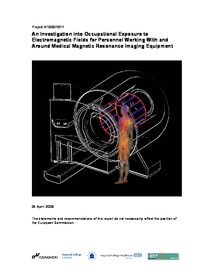An investigation into occupational exposure to electromagnetic fields for personnel working with and around medical magnetic resonance imaging equipment

Foundation for Research on Information Technology in Society, Zurich ; Imperial College, London
IT'IS - Zurich
2008
287 p.
electromagnetic fields ; magnetic resonance imaging ; exposure assessment ; hospital ; healthcare worker ; questionnaire survey ; evaluation of results
Occupational risks
English
Bibliogr.;Ill.
"Magnetic Resonance Imaging (MRI) is a rapidly developing diagnostic technology that provides an unmatched view inside the human body without applying ionizing radiation. Improved image quality and novel applications, however, generally require higher electromagnetic field (EMF) strengths and faster image acquisitions, both of which may result in an increase in the EMF exposure of patients and workers. Over the past 30 years, safety standards limiting human exposure to EMFs were developed by agencies (e.g., FDA [1] and NRPB [2]-[5]) and product standard organizations [6] to specifically address the safety of patients undergoing MRI scans as well as by standard bodies like ICNIRP [9]-[12] and ICES [7],[8] to establish safety limits covering the entire spectrum from DC to light. The MRI exposure guidelines are mainly based on specific research results on nerve stimulation by induced low frequency currents, whereas the latter standards are based on biological experiments conducted at different frequencies and conditions and that have been extrapolated to the entire spectrum including the MR relevant frequencies. Inconsistencies inevitably resulted, although no attempt was ever made to resolve them with targeted research projects. ..."
Digital
The ETUI is co-funded by the European Union. Views and opinions expressed are however those of the author(s) only and do not necessarily reflect those of the European Union or the ETUI.